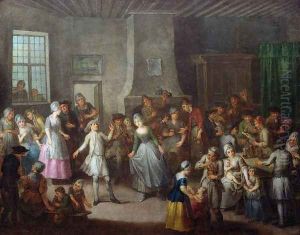Gabriel Jacques de Saint-Anton Paintings
Gabriel Jacques de Saint-Aubin, born on March 13, 1724, in Paris, France, was an 18th-century French draftsman and printmaker. Renowned for his etchings and detailed drawings, Saint-Aubin came from a family of artists and craftsmen; his father, Gabriel Germain de Saint-Aubin, was an embroiderer, which provided the younger Saint-Aubin with an early exposure to artistic forms and practices.
Despite his evident talent, Saint-Aubin's career was marked by financial struggle and a lack of recognition by the official art establishment of his time. He failed the admission tests to the prestigious Royal Academy of Painting and Sculpture multiple times, which limited his opportunities for patronage and official commissions. As a result, he often made a living by creating illustrations for booksellers and producing small-scale drawings and etchings.
Saint-Aubin was known for his keen observational skills, which were reflected in his works depicting various aspects of contemporary Parisian life, from the grandeur of public ceremonies to the bustle of market scenes. His works are characterized by their lively, spontaneous lines and attention to detail, often incorporating elements of satire and social commentary.
His drawing series 'Les Petites Misères de la vie humaine' (The Little Miseries of Human Life), co-created with the writer Jean-Baptiste Legrand, humorously illustrated everyday inconveniences and was well-received, reflecting the increasing public appetite for social satire during the Enlightenment.
Despite his talent, Saint-Aubin remained relatively obscure during his lifetime, overshadowed by more prominent artists. It wasn't until the 20th century that his work began to be reassessed and celebrated for its originality and insight into 18th-century French society.
Gabriel Jacques de Saint-Aubin died on February 14, 1803, in Paris. Posthumously, his art has been collected and exhibited in various museums around the world, including the Louvre in Paris and the Metropolitan Museum of Art in New York, where art lovers can appreciate his unique contributions to French art history.







